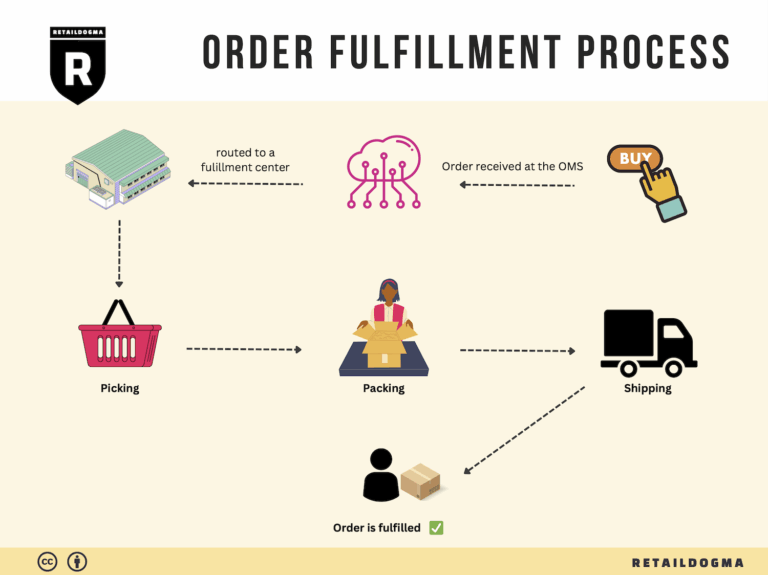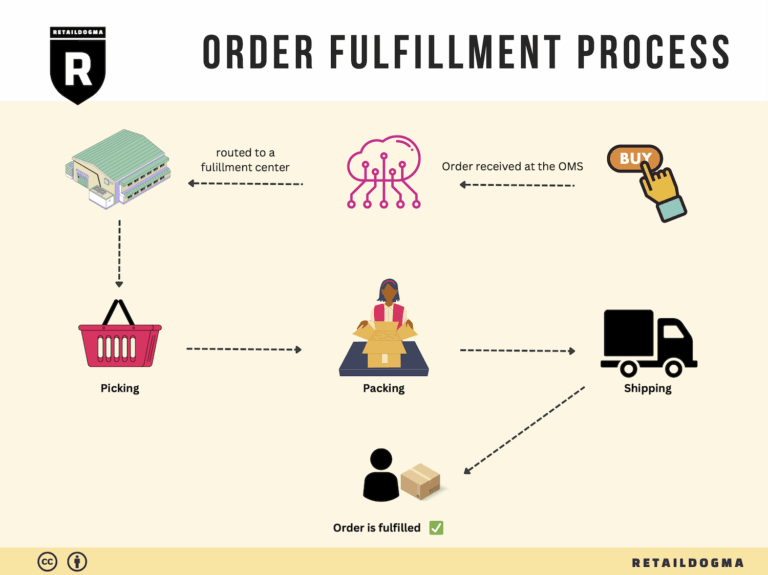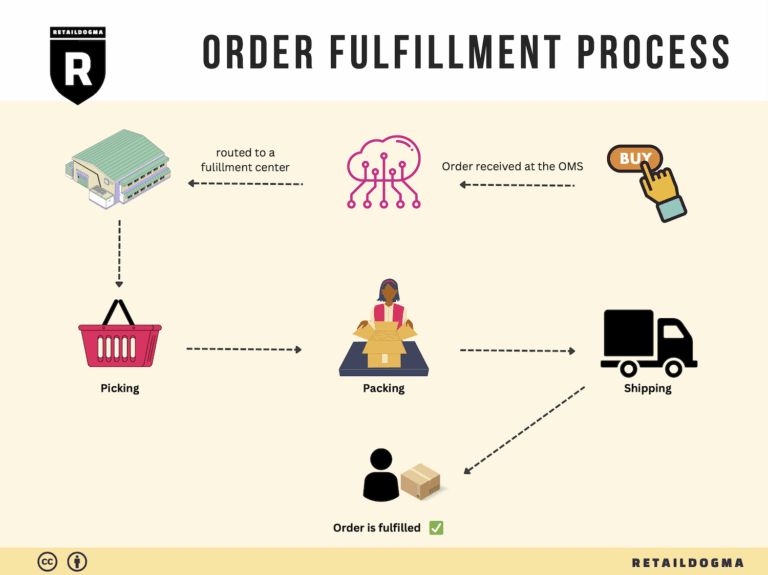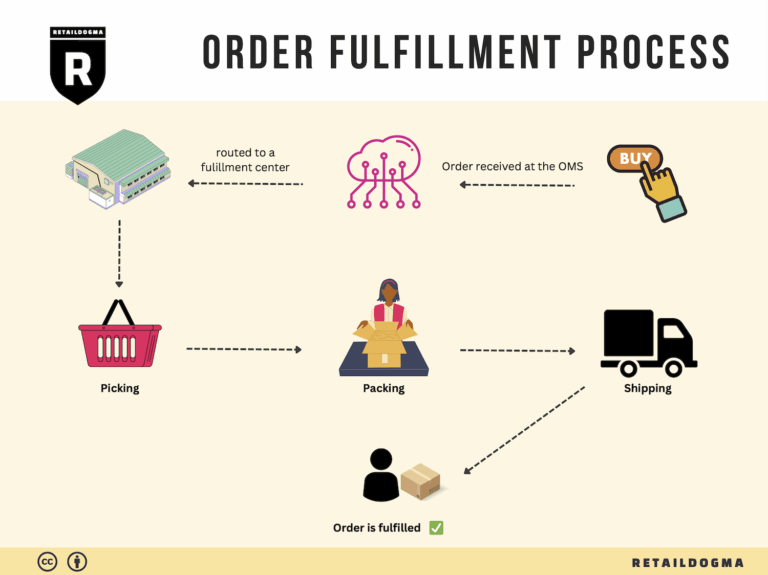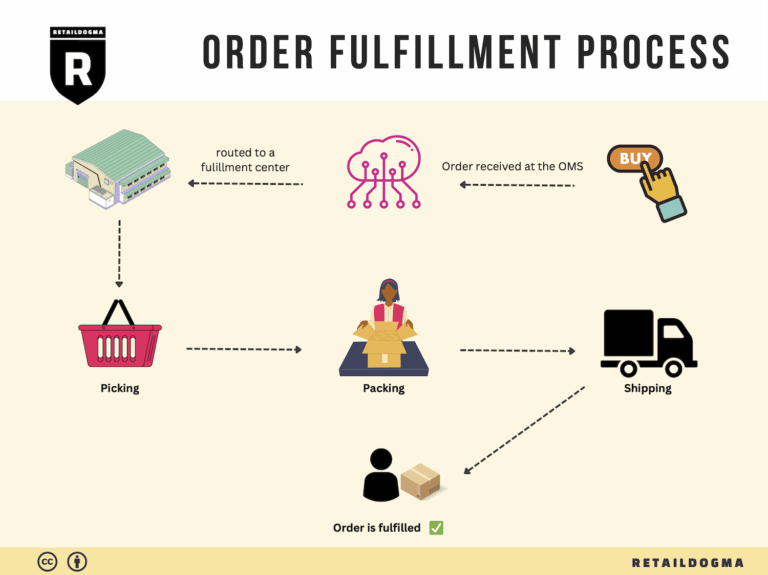Ecommerce Fulfillment Services: The Ultimate Guide (2025)
What is E-commerce Fulfillment? An Introduction for Growing Businesses
Understanding the Fulfillment Process
As your e-commerce business begins to grow, you may find yourself grappling with the complexities of packing and shipping orders. This common pain point can lead to frustration and inefficiencies, diverting your focus away from scaling your sales and nurturing customer relationships. Fulfillment, at its core, is the process of getting a product from your warehouse or storage to your customer’s doorstep. This seemingly simple task encompasses a range of activities, including inventory management, order processing, picking, packing, and shipping.
The Importance of Effective Fulfillment
For growing online businesses, mastering fulfillment is crucial. A streamlined fulfillment process not only enhances customer satisfaction through timely deliveries but also helps reduce operational costs. In this guide, we will explore various fulfillment models, including Third-Party Logistics (3PL) and Fulfillment by Amazon (FBA), to give you a clearer understanding of your options. Each model has its benefits and challenges, and selecting the right one can significantly impact your business’s efficiency and scalability.
Key Components of Fulfillment
In addition to discussing different fulfillment models, we will delve into core services that fulfillment partners typically offer. These include inventory storage, order processing, packing, shipping, and returns management. Understanding these components will help you assess which services align best with your business needs and customer expectations.
Choosing the Right Fulfillment Partner
Selecting the right fulfillment partner is a critical decision for your business. We will provide practical advice on how to evaluate potential partners based on factors such as technology integration, geographical reach, service offerings, and pricing. The right partner can streamline your operations, allowing you to focus on growth while ensuring that your customers receive their orders promptly and accurately.
Pricing Considerations
Lastly, we will cover pricing structures for fulfillment services, enabling you to budget effectively and avoid unexpected costs. Understanding how different providers charge for their services can help you make informed decisions that align with your financial goals.
Empowering Your Logistics Strategy
The goal of this guide is to empower e-commerce business owners, operations managers, and entrepreneurs to make smart, strategic decisions regarding their logistics. By demystifying the fulfillment process and providing actionable insights, we aim to help you optimize your operations and drive your business forward. Let’s navigate the world of e-commerce fulfillment together, ensuring that your logistics support your growth ambitions.

What You’ll Learn In This Guide
- What is E-commerce Fulfillment? An Introduction for Growing Businesses
- The Order Fulfillment Process: From ‘Buy’ Button to Customer’s Door
- Comparing Fulfillment Models: In-House vs. 3PL vs. Dropshipping
- A Deep Dive into Amazon FBA: Pros, Cons, and Who It’s For
- Core Services Offered by Fulfillment Centers
- How to Choose a Fulfillment Partner: A 6-Point Checklist
- Understanding Fulfillment Pricing: A Breakdown of Common Fees
- Frequently Asked Questions (FAQs) about Fulfillment
- Conclusion: Is Outsourcing Fulfillment the Right Move for Your Business?
- Important Disclaimer
The Order Fulfillment Process: From ‘Buy’ Button to Customer’s Door
1. Receiving Inventory
The order fulfillment process begins with receiving inventory at the fulfillment center. When products arrive, they are unloaded from delivery trucks and checked against the purchase orders to ensure accuracy. This step is critical for maintaining inventory integrity and preventing discrepancies that can lead to stockouts or overstock situations.
During this phase, each item is assigned a Stock Keeping Unit (SKU), a unique identifier that helps track products throughout the supply chain. Efficient receiving processes can significantly reduce lead times and improve overall operational efficiency. By accurately scanning and logging incoming inventory, businesses can ensure that they have the right products available for customer orders, thus enhancing customer satisfaction.
2. Warehouse Storage
Once the inventory has been received and sorted, it is placed into warehouse storage. This step involves organizing products in a way that maximizes space and improves accessibility. Proper storage techniques, such as using vertical space and employing different storage methods (e.g., pallet racking, shelving), are vital for optimizing warehouse operations.
In this phase, items are stored in designated areas according to their SKU, which simplifies the picking process later on. The importance of efficient warehouse storage cannot be overstated; it directly impacts the speed at which orders can be fulfilled. Utilizing technology, such as warehouse management systems (WMS), can facilitate real-time tracking of inventory levels and locations, ensuring that stock is easily accessible when needed.
3. Order Picking
The next step is order picking, where warehouse staff or automated systems retrieve products from storage in response to customer orders. This process can involve various methods, including single order picking, batch picking, or zone picking, depending on the volume and nature of the orders.

A critical tool in this step is the pick list, which details the items to be collected for each order, including their locations within the warehouse. Effective order picking is essential for maintaining speed and accuracy, as any mistakes can lead to incorrect orders being shipped, resulting in increased returns and diminished customer trust. As e-commerce businesses scale, investing in automation and advanced picking technologies, such as mobile devices or robotic systems, can enhance efficiency and accuracy in this phase.
4. Order Packing
After the items have been picked, they move on to the order packing stage. This step involves carefully packaging the products for shipment, ensuring they are secure and protected during transit. Proper packing is crucial for minimizing damage and returns, as well as ensuring that items arrive in excellent condition.
During packing, items are often scanned again to confirm they match the order before being placed into boxes. This process may also involve utilizing packing slips, which provide customers with details about their orders, including item descriptions and return instructions. Implementing efficient packing processes, such as customizing box sizes using automated packing machines, can reduce material costs and improve sustainability by minimizing waste.
5. Shipping & Delivery
The final stage is shipping and delivery, where packed orders are loaded onto delivery trucks and sent to customers. This step is vital for the overall customer experience, as timely and accurate deliveries can significantly influence customer satisfaction and loyalty.
In the shipping phase, technology plays a key role. Shipping software can optimize routes and schedules, ensuring that packages are delivered in the most efficient manner possible. Additionally, tracking systems allow customers to monitor their orders in real-time, providing transparency and peace of mind. Successful shipping strategies can include partnerships with various carriers, offering options for expedited delivery, and utilizing regional fulfillment centers (like the Amazon Fulfillment Center in Kent, WA) to shorten delivery times.
In conclusion, understanding and optimizing each step of the order fulfillment process is essential for e-commerce businesses looking to scale effectively. By focusing on efficiency and accuracy from receiving inventory to shipping and delivery, businesses can enhance their operational performance and improve customer satisfaction, ultimately driving sales and growth.
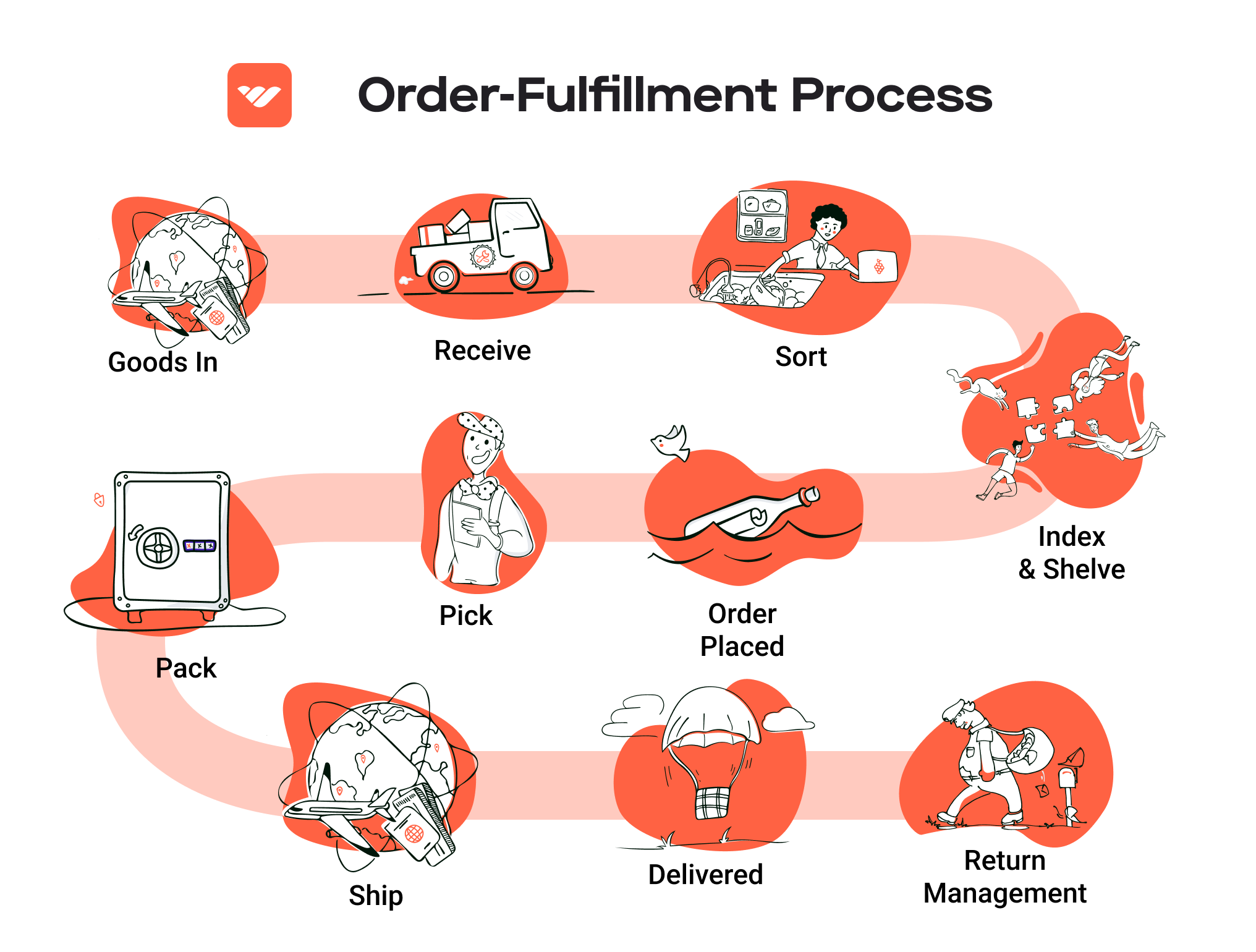
Comparing Fulfillment Models: In-House vs. 3PL vs. Dropshipping
Comparison of Fulfillment Models
| Model | Who Handles Inventory | Best For (Business Stage) | Key Advantage | Key Disadvantage |
|---|---|---|---|---|
| In-House Fulfillment | Business Owner | Established Businesses | Full control over inventory and operations | High overhead costs and resource-intensive |
| Third-Party Logistics (3PL) | 3PL Provider | Scaling Businesses | Scalable solutions and reduced operational burden | Less control over inventory and processes |
| Dropshipping | Supplier | Startups and Small Businesses | Low startup costs and no inventory risk | Lower profit margins and reliance on suppliers |
In-House Fulfillment
In-house fulfillment involves managing all aspects of the logistics process within your own facilities. This model is typically adopted by established businesses that have the necessary resources and infrastructure to handle inventory, warehousing, order processing, and shipping. One of the primary advantages of in-house fulfillment is the level of control it offers. Businesses can manage inventory directly, maintain quality standards, and ensure faster shipping times. However, this model comes with significant disadvantages, including high overhead costs related to warehousing, staffing, and technology investments. Additionally, managing logistics can divert focus from core business activities, which may hinder growth.
Third-Party Logistics (3PL)
Third-party logistics (3PL) providers offer businesses a way to outsource their fulfillment processes to specialized companies. This model is ideal for scaling businesses that want to expand their operations without the burden of managing warehousing and shipping logistics. Key advantages of using a 3PL include scalability, as these providers can quickly adjust to changing demand, and reduced operational burdens, allowing business owners to focus on other areas such as marketing and product development. However, one significant disadvantage is the loss of control over inventory and fulfillment processes. Companies must rely on the 3PL’s capabilities and efficiency, which can lead to issues such as inventory discrepancies and slower response times if not properly managed.
Dropshipping
Dropshipping is a fulfillment model where retailers sell products without holding inventory. Instead, when a business sells a product, it purchases the item from a third-party supplier who then ships it directly to the customer. This model is particularly appealing for startups and small businesses due to its low startup costs and minimal risk related to unsold inventory. The primary advantage of dropshipping is that it allows entrepreneurs to test markets and products without significant upfront investment. However, dropshipping also has its drawbacks, including lower profit margins and a heavy reliance on suppliers for order fulfillment. Issues such as stockouts or shipping delays can directly affect customer satisfaction and brand reputation, making it crucial for dropshippers to choose reliable suppliers.
Conclusion
Choosing the right fulfillment model depends on various factors, including the size of your business, available resources, and long-term growth goals. In-house fulfillment offers control but at a high cost; 3PL provides scalability with less operational involvement; and dropshipping minimizes risk but can compromise profit margins. Evaluating your business’s specific needs and future ambitions will help you make the most informed decision regarding the fulfillment model that best aligns with your operational strategy.
A Deep Dive into Amazon FBA: Pros, Cons, and Who It’s For
Understanding Fulfillment by Amazon (FBA)
Fulfillment by Amazon (FBA) is a service offered by Amazon that allows e-commerce sellers to store their products in Amazon’s fulfillment centers. Amazon then takes care of storage, packaging, and shipping of the products directly to the customers. The FBA program also handles customer service and returns, making it an attractive option for many sellers looking to streamline their operations and scale their businesses.
When a seller enrolls in FBA, they send their products to Amazon’s fulfillment centers, such as the one located in Kent, WA. Amazon uses advanced technology, including conveyor belts and autonomous robots, to efficiently manage the movement of products within the warehouse. Once a customer places an order for a product that is fulfilled by Amazon, the item is picked, packed, and shipped by Amazon, often with the added benefit of fast and reliable delivery options like Amazon Prime.
How FBA Works
-
Product Preparation: Sellers must prepare their products according to Amazon’s guidelines, which may include labeling and packaging requirements.
-
Shipping to Amazon: Once the products are ready, sellers ship them to Amazon’s fulfillment centers. Amazon provides specific shipping plans, including which fulfillment center to send products to.
-
Storage: Products are stored in Amazon’s warehouses until sold. Amazon utilizes sophisticated inventory management systems to keep track of stock levels.
-
Order Processing: When a customer places an order, Amazon’s system automatically processes it. The product is picked from the shelf, packed into a box, and shipped to the customer.
-
Customer Service: Amazon handles all customer inquiries and returns related to FBA products, allowing sellers to focus on other aspects of their business.
-
Payment: After the sale, Amazon deducts FBA fees from the proceeds and transfers the remaining amount to the seller.
Pros of Using FBA
1. Prime Eligibility
Products fulfilled through FBA are automatically eligible for Amazon Prime, giving sellers access to a vast pool of Prime members who prioritize fast shipping. This can significantly increase the chances of sales, as Prime members are more likely to purchase products that offer free two-day shipping.
2. Customer Trust
Amazon has built a strong reputation for customer service and reliability. By using FBA, sellers can leverage Amazon’s trusted brand, which can lead to higher conversion rates. Customers are more likely to buy from sellers that offer FBA because they know they will receive their orders quickly and have the option for easy returns.
3. Multi-Channel Fulfillment
FBA is not limited to sales on Amazon. Sellers can also use FBA to fulfill orders from their own e-commerce websites or other marketplaces. This multi-channel fulfillment capability allows businesses to centralize their inventory management and streamline shipping processes.
4. Scalability
FBA allows sellers to scale their businesses without the need to invest in their own warehousing and logistics infrastructure. As sales grow, sellers can send more inventory to Amazon’s fulfillment centers and rely on Amazon’s efficient systems to handle order processing.
Cons of Using FBA
1. High Fees
While FBA provides many benefits, it comes at a cost. Sellers are subject to various fees, including storage fees for inventory stored in Amazon’s warehouses and fulfillment fees for each order processed. These fees can add up quickly, especially for products with lower margins.
2. Strict Inventory Rules
Amazon has strict inventory management policies that sellers must adhere to. This includes limits on how much inventory can be stored and requirements for product preparation. Sellers must stay on top of these rules to avoid penalties or having their accounts suspended.
3. Commingling Risks
FBA operates on a commingling model, meaning that products from different sellers may be stored together in the same fulfillment center. This can pose risks for sellers, as it may lead to issues with counterfeit products or mislabeling. Sellers may receive returns that were not originally theirs, complicating inventory management.
4. Loss of Control
By outsourcing fulfillment to Amazon, sellers relinquish some control over the customer experience. This includes packaging, shipping speed, and customer service interactions. Any issues that arise may affect the seller’s brand reputation, even if they are due to Amazon’s processes.
Who is FBA Best For?
Fulfillment by Amazon is particularly well-suited for:
-
New Entrepreneurs: Those starting an e-commerce business can benefit from the infrastructure and logistics support FBA provides, allowing them to focus on marketing and product development rather than fulfillment.
-
Small to Medium-Sized Businesses: Companies that do not have the resources to manage their own warehousing and shipping can scale quickly by leveraging FBA.
-
Sellers with High Sales Volume: Businesses that anticipate high sales volume can take advantage of Amazon’s efficient fulfillment systems, potentially reducing shipping times and increasing customer satisfaction.
-
Brands Seeking Exposure: Sellers looking to expand their reach and visibility can benefit from Amazon’s massive customer base and the trust associated with the Amazon brand.
In conclusion, while FBA presents a compelling option for many e-commerce businesses, it is essential for sellers to weigh the pros and cons carefully. Understanding the operational nuances and financial implications of using FBA will help businesses make informed decisions that align with their growth strategies.
Core Services Offered by Fulfillment Centers
Inventory Management & Warehousing
Inventory management and warehousing are foundational services provided by fulfillment centers that directly impact an e-commerce business’s operational efficiency. Fulfillment centers, such as Amazon’s facility in Kent, WA, offer extensive storage solutions that allow businesses to store products close to their customer base. This proximity facilitates faster shipping and delivery times, which is crucial in today’s fast-paced e-commerce environment.
Through sophisticated inventory management systems, fulfillment centers track stock levels in real-time, ensuring that businesses can maintain optimal inventory levels. This reduces the risk of stockouts and overstock situations, both of which can significantly impact cash flow and customer satisfaction. Additionally, advanced analytics enable businesses to forecast demand accurately, allowing for more strategic purchasing decisions and improved inventory turnover rates.
By outsourcing inventory management and warehousing to a fulfillment center, e-commerce businesses can focus on core activities such as marketing and customer engagement, rather than the logistical challenges of storage and stock management.
Pick and Pack Services
Pick and pack services are critical to the fulfillment process, encompassing the selection and packaging of products for shipment. Fulfillment centers employ a systematic approach to picking items from storage, using technology such as barcode scanners and automated systems to ensure accuracy and efficiency.
The packing phase is equally important, as it involves preparing the products for shipment in a way that minimizes damage during transit. Many fulfillment centers utilize custom packaging solutions that not only protect the items but also enhance the unboxing experience for customers. This is particularly relevant for e-commerce businesses looking to build brand loyalty and create memorable customer experiences.
The benefits of utilizing pick and pack services include reduced labor costs, enhanced order accuracy, and faster processing times. By leveraging the expertise of fulfillment centers, e-commerce businesses can ensure that their orders are fulfilled quickly and correctly, leading to higher customer satisfaction and repeat purchases.
Kitting and Assembly
Kitting and assembly services allow e-commerce businesses to offer bundled products or custom configurations, providing customers with unique offerings that can differentiate them from competitors. Fulfillment centers can assemble products or combine multiple items into a single package before shipping, which is particularly useful for businesses that sell complex products or gift sets.
For instance, a company that sells beauty products might offer a “spa day kit” that includes a variety of items such as bath bombs, lotions, and candles. The fulfillment center would handle the assembly of these items into a cohesive package, ensuring that everything is included and correctly presented.
The primary advantage of kitting and assembly services is the ability to streamline the production and shipping processes. By having fulfillment centers manage these tasks, e-commerce businesses can reduce the time and labor associated with preparing products for sale. This not only leads to cost savings but also allows businesses to respond more quickly to market demands and customer preferences.
Returns Management (Reverse Logistics)
Returns management, or reverse logistics, is an essential service offered by fulfillment centers that can significantly impact customer satisfaction and brand loyalty. In the world of e-commerce, where return rates can be as high as 30%, having a streamlined process for handling returns is crucial.
Fulfillment centers provide businesses with the infrastructure to manage returns efficiently. This includes receiving returned items, inspecting their condition, restocking them if they are in sellable condition, and processing refunds or exchanges as needed. By automating and organizing the returns process, fulfillment centers help minimize the costs associated with returns while ensuring a positive experience for customers.
The benefits of effective returns management include improved customer trust and satisfaction, as customers appreciate hassle-free return processes. Additionally, businesses can gain valuable insights into return reasons, which can inform product development and marketing strategies. By addressing the underlying causes of returns, e-commerce businesses can enhance product quality and ultimately reduce return rates.
In summary, fulfillment centers like Amazon’s facility in Kent, WA, provide a suite of core services that can help e-commerce businesses scale efficiently. From inventory management and warehousing to pick and pack services, kitting and assembly, and returns management, these services allow businesses to focus on growth while ensuring that their logistics and operations run smoothly. By partnering with a fulfillment center, e-commerce businesses can enhance their operational capabilities, improve customer satisfaction, and ultimately drive sales.
How to Choose a Fulfillment Partner: A 6-Point Checklist
Location & Warehouse Network
Importance: The geographical location of your fulfillment partner significantly impacts shipping times and costs. A partner with a well-distributed warehouse network can expedite delivery to your customers, enhancing their experience and potentially reducing shipping expenses.
Questions to Ask:
– Where are your warehouses located, and how does that align with my customer base?
– What is your average shipping time to key regions?
– Do you have plans to expand your warehouse network in the future?
Technology & Integrations
Importance: In today’s e-commerce landscape, technology plays a crucial role in streamlining operations. A fulfillment partner should offer robust technology solutions that can integrate seamlessly with your existing systems, such as your e-commerce platform, inventory management, and customer relationship management (CRM) software.
Questions to Ask:
– What technology platforms do you use for inventory management, order processing, and shipping?
– Can your systems integrate with my current e-commerce platform (e.g., Shopify, WooCommerce, Amazon)?
– How do you handle inventory tracking and reporting?
Specializations (e.g., Cold Storage, Oversized Items)
Importance: Depending on the nature of your products, you may require a fulfillment partner that specializes in certain areas, such as cold storage for perishables, handling oversized items, or fragile goods. This specialization can ensure that your products are stored and shipped under optimal conditions.
Questions to Ask:
– Do you have specific facilities or capabilities for handling specialized products?
– What measures do you take to ensure product integrity during storage and transit?
– Can you accommodate seasonal fluctuations in inventory for specialized items?
Scalability & Capacity
Importance: As your business grows, your fulfillment needs will likely change. A good fulfillment partner should have the capacity to scale operations up or down based on demand fluctuations. This flexibility is crucial for managing peak seasons, such as holiday sales or product launches.
Questions to Ask:
– What is your current capacity, and how do you manage peak seasons?
– How quickly can you scale operations if my order volume increases?
– Are there any limitations to your scalability that I should be aware of?
Pricing and Contracts
Importance: Understanding the pricing structure is vital to ensure that your fulfillment costs align with your business model. Look for transparency in pricing and clarity in contract terms to avoid unexpected fees that could affect your profit margins.
Questions to Ask:
– Can you provide a detailed breakdown of your pricing structure (e.g., pick and pack fees, storage fees, shipping rates)?
– Are there any hidden fees or surcharges that I should be aware of?
– What are the terms for contract termination or changes in service levels?
Customer Support & Reviews
Importance: Reliable customer support is essential for addressing any issues that may arise during the fulfillment process. A partner with a strong reputation for customer service can help you resolve problems quickly, minimizing disruptions to your business.
Questions to Ask:
– What support options do you offer (e.g., phone, email, chat), and what are your response times?
– Can you provide references or testimonials from current clients?
– How do you handle disputes or service issues, and what is your escalation process?
Conclusion
Choosing the right fulfillment partner is a critical decision that can significantly influence your e-commerce operations. By using this checklist, you can evaluate potential partners based on key factors such as location, technology, specialization, scalability, pricing, and customer support. Taking the time to ask the right questions will not only help you find a partner that meets your current needs but also one that can grow with your business, ensuring long-term success in your e-commerce endeavors.
Understanding Fulfillment Pricing: A Breakdown of Common Fees
Initial Setup Fees
When partnering with a fulfillment center, businesses often encounter initial setup fees. These charges cover the costs associated with onboarding your products into the system. Typically, the setup process involves integrating your e-commerce platform with the fulfillment center’s technology, creating inventory listings, and setting up any necessary account management processes.
The calculation of initial setup fees can vary widely depending on the complexity of your operations. For instance, if you require customized software integration or specialized storage solutions for unique products, expect higher fees. Conversely, basic setups for standard products may incur lower costs. It’s essential to clarify what services are included in the setup fee to avoid unexpected charges later on.
Receiving Fees
Receiving fees are incurred when the fulfillment center takes possession of your inventory. This fee covers the labor and resources needed to unload, inspect, and store your products. The calculation of receiving fees is typically based on the number of items being received or the weight of the shipment.
For example, a fulfillment center may charge a flat fee per pallet or per item. Additional costs may arise if your products require special handling or if they are received in bulk, necessitating more labor. Understanding the specifics of how receiving fees are calculated can help you budget effectively and negotiate favorable terms.
Storage Fees (per pallet/bin)
Once your inventory is stored in the fulfillment center, storage fees apply. These fees are charged based on the amount of space your products occupy, typically calculated on a per-pallet or per-bin basis. Storage fees can fluctuate depending on the time of year; for example, many fulfillment centers implement higher rates during peak seasons like the holidays due to increased demand for warehouse space.
When assessing storage fees, consider the following factors: the duration your inventory will be stored, the type of products (as some may require climate control or special conditions), and any potential discounts for long-term storage. Some fulfillment centers offer tiered pricing, which could lead to cost savings if you can predict longer storage needs.
Pick & Pack Fees (per item/order)
Pick and pack fees are charged for the labor involved in selecting items from inventory and packaging them for shipment. This fee is critical for e-commerce businesses as it directly impacts order fulfillment efficiency and accuracy.
Typically, pick and pack fees are calculated on a per-item or per-order basis. For instance, a fulfillment center might charge a flat fee for each order processed, plus an additional charge for each item included in that order. This model incentivizes businesses to streamline their order processes. It’s advisable to discuss the specifics of these fees, including any potential surcharges for custom packing or special requests, to ensure you are not overpaying.
Shipping Fees
Shipping fees are a significant factor in fulfillment pricing and can vary based on several elements, including the destination, weight, and dimensions of the package. Fulfillment centers often have relationships with multiple carriers, allowing them to offer competitive shipping rates.
Shipping fees are typically calculated based on the carrier’s pricing model, which may include flat rates, zone-based pricing, or weight-based pricing. Understanding your shipping options can help you choose the most cost-effective method. Additionally, consider any accessorial charges, such as fuel surcharges or residential delivery fees, that may apply.
Tips for Getting an Accurate Quote
-
Be Detailed: Provide potential fulfillment partners with comprehensive details about your product types, expected order volumes, and any specific requirements. The more information you provide, the more accurate your quote will be.
-
Ask for Itemized Quotes: Request itemized quotes that break down each fee type. This transparency will help you understand where your costs are coming from and identify areas for negotiation.
-
Compare Multiple Providers: Don’t settle for the first quote you receive. Compare offers from multiple fulfillment centers to find the best balance of cost and service quality.
-
Inquire About Discounts: Many fulfillment centers offer discounts for high-volume orders or long-term contracts. Always ask about potential savings opportunities.
-
Review Contracts Carefully: Before signing any agreements, carefully review the terms regarding fees, especially for seasonal fluctuations or unexpected charges, to avoid surprises.
By understanding these common fulfillment pricing models and following these tips, e-commerce businesses can make informed decisions that enhance their operational efficiency and cost-effectiveness.
Frequently Asked Questions (FAQs) about Fulfillment
1. What is the Amazon Fulfillment Center in Kent, WA?
The Amazon Fulfillment Center in Kent, WA, known as HBF2, is a large-scale facility specializing in storing, packing, and shipping a wide range of products. It operates 24/7, utilizing advanced technologies such as conveyor belts and autonomous robots to efficiently process millions of items daily.
2. How does the fulfillment process work at the Kent facility?
The fulfillment process at the Kent facility involves several steps: products are received, scanned, and stowed in yellow storage bins. They are then moved through a network of conveyor belts and robotic systems, where they are picked, packed, and shipped to customers. The facility employs a “U” shape layout to streamline the flow of goods from receiving to shipping.
3. What types of products are processed at the Kent fulfillment center?
The Kent fulfillment center primarily handles small items, including electronics, books, and various consumer goods. It is equipped to manage a diverse inventory to meet the demands of Amazon’s extensive customer base.
4. What is the difference between a warehouse and a fulfillment center?
A warehouse is primarily focused on storing products, whereas a fulfillment center is designed for processing orders and shipping them directly to customers. Fulfillment centers often include advanced logistics and technology to handle packing and shipping efficiently, which is essential for e-commerce operations.
5. What is a third-party logistics provider (3PL)?
A third-party logistics provider (3PL) is a company that offers logistics services to businesses, including warehousing, fulfillment, and shipping. Businesses may partner with a 3PL to outsource their logistics needs, allowing them to focus on core operations while benefiting from the expertise and resources of the 3PL.
6. How much do fulfillment services cost?
Fulfillment service costs can vary widely based on several factors, including order volume, storage space requirements, and specific services needed (e.g., packing, shipping, returns processing). On average, businesses can expect to pay fees based on a per-order basis, monthly storage fees, and additional charges for value-added services.
7. How can businesses benefit from using the Kent fulfillment center?
Utilizing the Kent fulfillment center allows businesses to leverage Amazon’s extensive logistics network for faster shipping times, access to advanced technology for order processing, and the ability to scale operations without the need for significant investments in warehousing and logistics infrastructure.
8. What are the operational hours of the Amazon Fulfillment Center in Kent?
The Kent fulfillment center operates 24 hours a day, seven days a week, allowing for continuous processing of orders and efficient inventory management to meet customer demand, especially during peak seasons.
9. What safety measures are in place at the Kent fulfillment center?
Amazon emphasizes operational safety within its fulfillment centers, including safety training for employees, ergonomic assessments, and monitoring of work conditions. However, the facility has faced scrutiny over workplace safety, and the company continues to address these concerns through ongoing evaluations and improvements.
10. How can businesses get started with fulfillment services through Amazon?
To get started with fulfillment services through Amazon, businesses can enroll in the Fulfillment by Amazon (FBA) program. This program enables sellers to store their products in Amazon’s fulfillment centers, where Amazon takes care of storage, packaging, and shipping, allowing sellers to focus on growing their business. Interested businesses can sign up via the Amazon Seller Central platform.
Conclusion: Is Outsourcing Fulfillment the Right Move for Your Business?
Evaluating the Benefits of Outsourcing Fulfillment
Outsourcing fulfillment can be a transformative decision for e-commerce businesses aiming for growth. One of the most significant advantages is the time savings it offers. By delegating the complexities of warehousing, packing, and shipping to a dedicated fulfillment partner, business owners can focus on core activities like product development, marketing, and customer engagement. This shift not only enhances productivity but also ensures that your team is channeling their efforts where they can have the most impact.
Scalability is another critical benefit. As your business grows, so do your logistical demands. A robust fulfillment service provides the infrastructure to handle increased order volumes without the need for substantial upfront investment in warehouse space or technology. This flexibility allows you to adapt quickly to market changes, seasonal spikes, or new product launches, ensuring that your operations remain agile and responsive.
Moreover, partnering with a fulfillment expert brings invaluable industry knowledge and operational efficiencies that may not be feasible in-house. These providers often leverage advanced technology, like automated systems seen at facilities such as Amazon’s Kent center, which streamlines processes and reduces errors. Their expertise can improve order accuracy, enhance customer satisfaction, and ultimately drive repeat business.
Choosing the Right Partner for Growth
However, the benefits of outsourcing fulfillment hinge on selecting the right partner. It’s essential to assess potential providers based on their track record, technology capabilities, scalability, and customer service. A misalignment can lead to operational challenges that negate the advantages of outsourcing.
Call to Action
To determine if outsourcing fulfillment is the right next step for your business, consider conducting an audit of your current shipping processes. Analyze your order volume, shipping times, and customer feedback. This assessment can provide insights into your logistical pain points and help you identify if a fulfillment partner could enhance your operational efficiency and support your growth objectives. Make the strategic choice that positions your business for success.
Important Disclaimer
⚠️ Important Disclaimer
The information in this guide is for educational purposes. Fulfillment services, pricing, and platform features change frequently. Always conduct your own due diligence and consult with providers directly before making business decisions.

